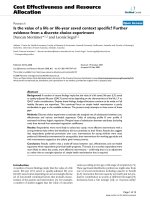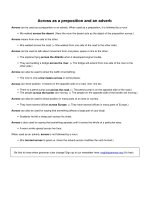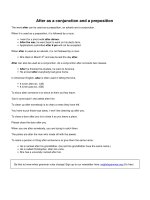Is it a preposition is it a conjunction or is it an adverb
Bạn đang xem bản rút gọn của tài liệu. Xem và tải ngay bản đầy đủ của tài liệu tại đây (216.46 KB, 6 trang )
Is it a preposition? Is it a conjunction? Or is it an adverb?
Exploring grammar - telling the difference between prepositions, conjunctions
and adverbs by looking at them in context.
We all know that in, on and from are prepositions.
Most of us know that and, but and because are conjunctions.
And I'm sure you all know that well, carefully and unfortunately are adverbs.
But what about words like after, since and until? Do these exercises to find out.
Is 'it' a preposition?
Quite a lot of people are finding this page by googling, "Is 'it' a preposition?". For them, ' it' is a
pronoun, so we won't be dealing with it in this post but you can read all about ' it' here.
Song exercise - Don't you want me - Human League
After the exercises there are some notes on the distinguishing features of prepositions,
conjunctions and adverbs. I also take a look at phrasal verbs and their particles.
Exercise 1
The word since can be a preposition, conjunction or an adverb. Try and
decide which part of speech since is in each of these sentences (there are
two of each), then check.
prep conj adv
1. I used to know her at school but I haven't seen her since.
2. Since meeting you my life has changed completely.
3. I haven't seen her since she moved to London.
4. I haven't had anything to eat since lunch.
5. Me, smoke?! I've long since given up smoking.
6. Since you're here, why don't you stay for lunch.
Exercise 2
Now complete the tips for recognising which part of speech they are.
prep conj adv
1. Is followed by a clause (subject + verb etc) or an adverb
2. Stands alone or with a verb
3. Is followed by a noun, pronoun or gerund (-ing form)
Exercise 3
Decide which part of speech the underlined words are in these sentences.
Note that yesterday is an adverb here.
prep conj adv
1. When did you last see your father?
2.
Make sure you put a scarf on. It's cold out there.
3.
Can you put in on the table, please.
4.
Hard Times was written by Charles Dickens.
5.
Once you've finished that, you can go home.
6.
Doesn't time go by so quickly?
7.
As it grew light, she could see more of the scene.
8.
Until yesterday, I'd never set eyes on him.
9.
Haven't we met before somewhere?
10. When you're as old as I am, you'll understand.
11. Where's Jenny? I think she went outside.
12. I seem to remember meeting him once.
13. After such a lovely lunch, we should go for a nice walk.
14. Before watching TV, the children put all their toys away.
15. I'd offer to help, only I have to be at the station in an hour.
16. She was working as a waitress in a cocktail bar.
17. The bride was early and we only just arrived before her.
18. It's a small village, just outside London.
19. I saw David when I was in town.
20. I'm only asking you to help a little.
Exercise s2 - For each gap you filled, decide which part of speech (word
class) your answer is, and enter p for preposition, c for conjunction
or a for adverb in the small boxes on the right.
Some brief notes
Prepositions
1.
Prepositions always take an object, in the form of a noun (phrase), pronoun or gerund
(phrase). This is confusingly called the object of the preposition (2), and has nothing to do
with the object of the verb or sentence. (1)
I've made this jam (1) for your mother (2).
Except after a prepositional verb, when they are the same:
I've been looking for that jar of jam (1,2) Katie gave me.
2.
We quite often like to put the preposition at the end of a clause, making the object more
difficult to spot. But it's still there or implied. You just have to look a bit harder. This happens
especially in four cases:
1.
Direct questions - Who did you make the jam for?
object of the preposition = who (or the answer to who?)
2.
Relative clauses - That's the man (who / that) I gave the book to.
object of the preposition = the man (whoever or whatever the relative pronoun is referring to)
3.
Passives - The water heater needs to be looked at. It's got a problem.
object of the preposition - the water heater
4.
to infinitives - It's certainly something to hope for.
object of the preposition = it (or whatever it is referring to)
NB - We don't usually use whom in these constructions, only after a preposition. But a sentence
like: That's the man to whom I gave the book. would be considered by most of us to be
excessively formal and stiff, not to mention old-fashioned. And For whom did you make
jam?would be even more so.
Conjunctions
Conjunctions literally 'join together' and are of two types: co-ordinating and subordinating.
There are seven co-ordinating conjunctions, easily remembered with the mnemonic 'FANBOYS'
- for, and, nor, but, or, yet, so. These link two independent clauses and are always in the
middle, and would be difficult to confuse with prepositions or adverbs even though some of
them can also function as prepositions (for, but) and some as adverbs (but, yet, so).
The problem comes with the numerous subordinating conjunctions - before, after, since, until,
becauseetc. These are the start words of subordinate clauses, which can come before or after
the main clause.
Furthermore, there are often adverb or preposition versions of the same word. In this case you
have to look for complete clauses, with subject and verb etc. It the word in question is followed
by a complete clause it's likely to be a conjunction.
After he had washed up, he went through to watch some TV.
He left his job since they weren't paying him enough.
Note that some of these conjunctions are often used before adverbs of time:
Until now I'd always thought she was French. But in fact she's Belgian.
I saw him at lunchtime. Did you see him before then?
He write to me about a year ago. But since then, I haven't heard a word.
I'd never heard of her before today.
They're staying until tomorrow.
We've only lived here since last year.
Adverbs
Adverbs that can get confused with prepositions and conjunctions are usually those referring to
time or place.
Sometimes adverbs can look like prepositions:
Let's get down to brass tacks.
Oh, hello everyone. Come in, all of you.
And they all lived happily ever after.
Do you know when he's arriving?
But none of them have a prepositional object.
Sometimes adverbs can look a bit like conjunctions
The weekend is the only time when I can do the gardening.
As usual, it rained on my birthday.
Just for once, will you do as I ask?
Whenever did you come in? I never heard you.
In three of these examples, the words in bold do not connect clauses. In the first example we
have a relative clause referring to time.
Where and when
Where and when can be a bit confusing, especially when they introduce a clause (underlined in
the examples).
As adverbs
1.
o
o
2.
o
o
3.
o
o
4.
o
o
5.
o
o
o
Wh- questions
Where did you put my book?
When do we have to leave for the station?
Negatives
We'll meet again, (I) don't know where, (I) don't know when
They got married fairly recently, but I've no idea where or when.
Wh- clauses
Excuse me. Do you know where the station is?
I can't remember when the train leaves.
Relative clauses - defining
It's one of those towns where they have a weekly market.
This is the season when the countryside looks at its best.
Relative clauses - non-defining
And this of course is the Champs Elysée, where I first met Sandra.
It was in August, when the Parisians leave Paris to the tourists.
As conjunctions in subordinate adverbial clauses.
This is where they have the weekly market.
We went there when the countryside looked at its best.
Did you put it where I asked you to?
When I was out earlier on, I saw Peter.
I'll get it when I do the shopping later.
Where there's a will, there's a way.
Phrasal verbs - are the particles prepositions or adverbs?
A phrasal verb consists of a verb and one or more particles, either prepositions or adverb
particles. You can use phrasal verbs perfectly well without ever knowing which they are using,
but as we're trying to sort out this whole question of the difference between these parts of
speech, I thought we might as well include phrasal verbs.
Phrasal verbs are often divided into four types:
1.
those that don't take an object
o
I wish all these people would just go away.
o
Our car broke down during the holiday.
Without an object the particles can't be prepositions, so they must be adverbs.
2.
those that take an object and can be separated by that object
o
We're picking up the kids / picking the kids up after school.
o
Could you turn on the television / turn the television on, please?
o
I'll put on some music / put some music on, shall I?
Here it's not so clear, especially when we remember that if the object is a pronoun, it must go
between the verb and the particle. According to Shaw these are adverb particles, and taking an
object here is an exception to the normal rule.
3.
those that take an object, but that can't be separated by the object
o
'Here's looking at you, kid!'
o
We're looking after Sheila's kids for the afternoon.
o
She's looking for a new job.
These clearly take an object, so the particles are prepositions. For this reason this type of
phrasal verb is sometimes called a prepositional verb.
4.
those that have two particles. The particles can't be separated by the object.
o
We get on with the neighbours like a house on fire.
o
It looks like we've run out of coffee.
o
Do you think they will get away with it?
The second particle cannot be separated from its object, so must be a preposition. We can
however, sometimes separate the two particles with modifiers.
o
I get on really well with my in-laws.
o
I'm not putting up any more with your behaviour.
The first particle always stays with the verb, so it must be an adverb.
Phrasal verbs - some notes
1.
Some identical-looking pairs of verbs belong to different categories, e.g.:
o
He comes across as being a very knowledgeable young man.
o
We came across a lovely painting in the local auction sale.
In the first example, across is an adverb (Type 1), in the second it's a preposition (Type 3).
2.
We tend not to stress adjectives, except when they are followed by a pronoun.
o
I'm looking for a new mat for my bathroom.
o
But I haven't come across one yet.
3.
But adverbs are stressed as much or even more than the verb.
o
Can you turn on the lights, please?
o
I asked you to go away.
A note mainly to fellow teachers - Peeve 1
We all know what phrasal verbs are. Students may not exactly love them, but they know what
they are. But apparently this term is not trendy enough sounding for the writers of English
course books, who seem to think that multi-word verbs sound much sexier. There may well be
good linguistic reasons why this is a better name than the one we are all used to, but why fix
something when it ain't broke[sic]
The latest wheeze seems to be prepositional verbs. I've been using a newish book recently Language Leader Advanced - which I quite like, but out of the blue there is a section on
'prepositional verbs'. Now, as far as I am aware, this is not a term bandied around very much in
TEFL circles, and as the book is for advanced students, I thought maybe this was some exotic
type of verb I hadn't come across before. But no, it's just Type 3 phrasal verbs. Not that you'd
have known that from the book; phrasal verbs don't even get a mention. What's more, I'm pretty
sure that two out of the nine examples they give are not actually prepositional verbs, so I'm not
totally convinced they really understand the concept themselves.
The examples they give are:
come across, come up, deal with, get on, get over
look at, look into, look like, look around.
Try adding something, somebody or somewhere after each verb. With seven of them it works
fine, but with get on and come up? OK, you can get on a train, and perhaps come up the hill,
but that's not the meanings they give. In any case that would just be a verb followed by a
preposition, not a special construction.
There is an exercise with sentences where you have to replace the verbs in bold by choosing a
'prepositional verb' from a given selection. Two of them go like this:
How are you progressing at work.
An opportunity has arisen for a Twitter correspondent at Sky News Board.
and the expected answers are:
How are you getting on at work.
An opportunity has come up for a Twitter correspondent at Sky News Board.
Now correct me if I'm wrong (to quote Eddie Izzard), but where are those pesky 'objects of the
preposition' (see above). Nowhere to be seen, because both of these phrasal verbs are followed
by prepositions (at and for). The particles on and up are adverbs, so as far as I can see these
are not prepositional verbs at all, but Type 1 phrasal verbs. But then perhaps I'm missing
something. First confuse us with something we've never heard of, and then get it wrong to
confuse us even further!









